| Pages:
1
..
23
24
25
26
27 |
ecos
Hazard to Others
  
Posts: 464
Registered: 6-3-2014
Member Is Offline
Mood: Learning !
|
|
I don't like the idea of depending on O2 in air. it might not be enough for complete combustion.
from wikipedia :
| Quote: |
Tritonal is a mixture of 80% TNT and 20% aluminium powder, used in several types of ordnance such as air-dropped bombs. The aluminium improves the
total heat output and hence impulse of the TNT - the length of time during which the blast wave is positive. Tritonal is approximately 18% more
powerful than TNT alone.
|
Wow, 18% increase in power is very good !
is there anyway to calculate the improvement for other EM and the optimum percentage of Al ?
[Edited on 13-5-2015 by ecos]
|
|
|
Hennig Brand
International Hazard
    
Posts: 1284
Registered: 7-6-2009
Member Is Offline
Mood: No Mood
|
|
You can easily estimate the increase in heat output if you know the percent of Al in the charge and the extent of combustion. The particle size and
shape of the aluminum, as well as other factors, will greatly effect the power of the explosive though. I am not an expert on this, so if you dig a
little you will likely find more information about how to quantify this.
"A risk-free world is a very dull world, one from which we are apt to learn little of consequence." -Geerat Vermeij
|
|
|
ecos
Hazard to Others
  
Posts: 464
Registered: 6-3-2014
Member Is Offline
Mood: Learning !
|
|
I started to dig , it seems increasing the percentage of Al above a certain limit will decrease the power.
I found the optimum value for AN is 13% but most people use 10% of Al. in Tritonal they use 20%.
I couldn't find any mixture above 20% Al but no reason why.
|
|
|
ecos
Hazard to Others
  
Posts: 464
Registered: 6-3-2014
Member Is Offline
Mood: Learning !
|
|
Hi All,
I start to wonder, is it possible to make NG gel as a fine powder ? I was thinking that BB can be made fine powder using a ball mill. I was thinking
to use the same technique to get a fine powder of NG gel. This would remove the air bubbles inside the gel and make it possible to be used for shaped
charges
I found no detonation for NG/NC (91:9) for 2kg from 15 cm as indicated in figure below. this mean the ball mill jar can be smaller in size not to
exceed this critical diamater.
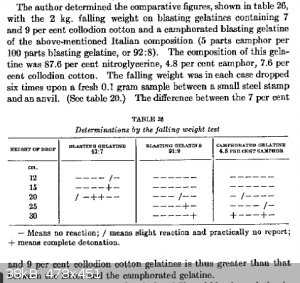
Ref : Nitroglycerine and Nitroglycerine Explosives: Phokion Naoum
page : 312
I am just afraid that decrease the size of NG gel would make it very sensitive to shock !.
any suggestions ?
[Edited on 14-7-2015 by ecos]
|
|
|
Metacelsus
International Hazard
    
Posts: 2531
Registered: 26-12-2012
Location: Boston, MA
Member Is Offline
Mood: Double, double, toil and trouble
|
|
Would powdering it even work? Would it just get mushed up? Maybe you could freeze it first, like in https://en.wikipedia.org/wiki/Cryogenic_grinding
but less extreme.
Anyway, do this at your own risk. I wouldn't be anywhere nearby.
|
|
|
ecos
Hazard to Others
  
Posts: 464
Registered: 6-3-2014
Member Is Offline
Mood: Learning !
|
|
as i understand, NG gel shouldn't be freezed or it would crystallize and be unstable -- thats why they mix NG with Nitroglycol !
|
|
|
ecos
Hazard to Others
  
Posts: 464
Registered: 6-3-2014
Member Is Offline
Mood: Learning !
|
|
short video about Gelatin dynamite : https://youtu.be/n3COSL_cIoc
I was shocked when i saw the process ! i thought NG is more sensitive than being treating like this(picture for the mixer) :
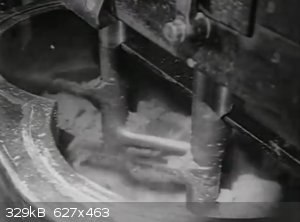
I was very scared when i deal with NG! I read many stories about how danger to handle NG and NC but this video show they are not that sensitive.
I try to avoid making blasting gelatin because i am scared to mix NG with NC and stir them with the thermometer.
any experience how to deal with NG ?
[Edited on 24-7-2015 by ecos]
I also found vidoes for people using syringe to deal with NG ; https://www.youtube.com/watch?v=Qhb3nxS4g84
i thought the pressure of syringe would explode it !
[Edited on 24-7-2015 by ecos]
|
|
|
Hennig Brand
International Hazard
    
Posts: 1284
Registered: 7-6-2009
Member Is Offline
Mood: No Mood
|
|
Yes, NG under normal conditions is much less sensitive than it is reported to be by many modern sources, however, I am still very careful when
handling it. If I am being more careful than needed and wasting a little time and energy it is much better than having an overconfident attitude
possibly/likely resulting in a tragic accident that would likely leave me maimed or killed.
It is an interesting video, thanks.
"A risk-free world is a very dull world, one from which we are apt to learn little of consequence." -Geerat Vermeij
|
|
|
ecos
Hazard to Others
  
Posts: 464
Registered: 6-3-2014
Member Is Offline
Mood: Learning !
|
|
I started to get confused of everything :
Wiki states :
| Quote: |
Early in its history, it was discovered that liquid nitroglycerin can be "desensitized" by cooling it to about 5 to 10 °C (40 to 50 °F). At this
temperature nitroglycerin freezes, contracting upon solidification. Thawing it out can be extremely sensitizing, especially if impurities are present
or the warming is too rapid.
|
In The process of synthesizing NG, it is required an ice path for washing and removing acids i.e, NG would exist in a medium with temperate almost
Zero !
for making blasting gelatine , it is preferred to cool NG from 0-5 degres to slow the gelatinization process !
it is also said that any acid traces would be dangerous for NG however, NG is synthesised in acid medium and left for some time!
I feel confused by different sources
[Edited on 25-7-2015 by ecos]
|
|
|
Hennig Brand
International Hazard
    
Posts: 1284
Registered: 7-6-2009
Member Is Offline
Mood: No Mood
|
|
Wikipedia is not always a reliable reference. It can be a convenient research starting point and the references at the bottom of the Wiki pages are
often good.
Frozen NG is very insensitive, but bits of frozen NG in liquid NG can be a very sensitive mixture as can mixtures with bits of sand or other hard
gritty substances in a sample of liquid NG for the same reason.
It is much easier to gelatinize NG with NC at slightly elevated temperatures. Not sure about industrial processes, but I have always found the
gelatinization process very slow without the help of a solvent and maybe a bit of heat, but then again I was not using the very fine, essentially
powdered, NC that is used industrially for the purpose.
Different concentrations of acid effect NG differently, also exposure time makes a difference. I have left spent mixed acids to stand in the dark for
one or two days after which I would often obtain as much as 10-15% more NG. I also remember extracting and then only crudely washing a small sample of
NG years ago and coming out the next morning to find it boiling and billowing red fumes from the small open beaker holding the sample.
"A risk-free world is a very dull world, one from which we are apt to learn little of consequence." -Geerat Vermeij
|
|
|
ecos
Hazard to Others
  
Posts: 464
Registered: 6-3-2014
Member Is Offline
Mood: Learning !
|
|
Hi Hennig,
regarding this part :
| Quote: |
Frozen NG is very insensitive, but bits of frozen NG in liquid NG can be a very sensitive mixture as can mixtures with bits of sand or other hard
gritty substances in a sample of liquid NG for the same reason.
|
I never used distilled water. Also dust can be a factor of things I use ! this mean the NG would be sensitive ?
I was also preparing to add Al powder to NG/NC mixture ! this sounds critical now !
|
|
|
Hennig Brand
International Hazard
    
Posts: 1284
Registered: 7-6-2009
Member Is Offline
Mood: No Mood
|
|
The sharp edges and corners on hard gritty substances with motion can result in localized high pressure and heat being generated between these
surfaces and each other or other surfaces which can sometimes be enough to result in initiation.
Not all dust is the same though. I couldn't say for sure how much of a sensitizer your particular type of dust is. I just try to avoid any
contaminants, but especially hard gritty contaminants. NG/NC mixtures are normally very insensitive and mixing in fine flake aluminum should be fine.
https://www.tedpella.com/company_html/hardness.htm
Mohs Scale
Hardness of Quartz (Vitreous Silica): 7
Hardness of Aluminum: 2-2.9
"A risk-free world is a very dull world, one from which we are apt to learn little of consequence." -Geerat Vermeij
|
|
|
ecos
Hazard to Others
  
Posts: 464
Registered: 6-3-2014
Member Is Offline
Mood: Learning !
|
|
Quote: Originally posted by Hennig Brand  | Wikipedia is not always a reliable reference. It can be a convenient research starting point and the references at the bottom of the Wiki pages are
often good.
Frozen NG is very insensitive, but bits of frozen NG in liquid NG can be a very sensitive mixture as can mixtures with bits of sand or other hard
gritty substances in a sample of liquid NG for the same reason.
It is much easier to gelatinize NG with NC at slightly elevated temperatures. Not sure about industrial processes, but I have always found the
gelatinization process very slow without the help of a solvent and maybe a bit of heat, but then again I was not using the very fine, essentially
powdered, NC that is used industrially for the purpose.
Different concentrations of acid effect NG differently, also exposure time makes a difference. I have left spent mixed acids to stand in the dark for
one or two days after which I would often obtain as much as 10-15% more NG. I also remember extracting and then only crudely washing a small sample of
NG years ago and coming out the next morning to find it boiling and billowing red fumes from the small open beaker holding the sample.
|
I think you mean frozen NG is sensitive !
I was reading today more about NG since it is the only HE I can prepare now:
book name : high explosives and propellants
Author ; S. Fordham
page 38

|
|
|
Bert
Super Administrator
        
Posts: 2821
Registered: 12-3-2004
Member Is Offline
Mood: " I think we are all going to die. I think that love is an illusion. We are flawed, my darling".
|
|
| Quote: |
I think you mean frozen NG is sensitive !
|
No, he meant exactly what he said.
Frozen NG is quite INsensitive. Partially frozen NG is bad news... Incautious attempts to thaw NG or NG explosives not formulated for cold weather use
are also a historically famous source of accidental explosions.
Too tired to dig out the references right now. Google George Mowbray, Hoosac tunnel, sleigh, frozen NG.
Rapopart’s Rules for critical commentary:
1. Attempt to re-express your target’s position so clearly, vividly and fairly that your target says: “Thanks, I wish I’d thought of putting it
that way.”
2. List any points of agreement (especially if they are not matters of general or widespread agreement).
3. Mention anything you have learned from your target.
4. Only then are you permitted to say so much as a word of rebuttal or criticism.
Anatol Rapoport was a Russian-born American mathematical psychologist (1911-2007).
|
|
|
Praxichys
International Hazard
    
Posts: 1063
Registered: 31-7-2013
Location: Detroit, Michigan, USA
Member Is Offline
Mood: Coprecipitated
|
|
Quote: Originally posted by Bert  |
Frozen NG is quite INsensitive. Partially frozen NG is bad news... Incautious attempts to thaw NG or NG explosives not formulated for cold weather use
are also a historically famous source of accidental explosions. |
Yes, I believe this to be correct. Think of the higher polyols. ETN is more sensitive when melted than frozen. NG should be the same way.
IIRC the reason frozen NG is more dangerous is that attempts to thaw the NG before electric heating was available lead to many accidents. Frozen NG in
handling equipment sometimes lead unknowledgeable operators to force equipment or warm it over a fire. I can find no account of thawing NG actually
exploding by itself other than in internet heresay. It doesn't make sense from a chemical standpoint anyway.
http://www.logwell.com/tales/frozen_nitroglycerin.html
EDIT: Whoops, wrong argument.
[Edited on 26-7-2015 by Praxichys]
|
|
|
Tabun
Harmless

Posts: 38
Registered: 17-4-2015
Member Is Offline
Mood: No Mood
|
|
Quote: Originally posted by ecos  | short video about Gelatin dynamite : https://youtu.be/n3COSL_cIoc
I was shocked when i saw the process ! i thought NG is more sensitive than being treating like this(picture for the mixer) :
I was very scared when i deal with NG! I read many stories about how danger to handle NG and NC but this video show they are not that sensitive.
I try to avoid making blasting gelatin because i am scared to mix NG with NC and stir them with the thermometer.
any experience how to deal with NG ?
[Edited on 24-7-2015 by ecos]
I also found vidoes for people using syringe to deal with NG ; https://www.youtube.com/watch?v=Qhb3nxS4g84
i thought the pressure of syringe would explode it !
[Edited on 24-7-2015 by ecos] |
I was also a little scared...never worked with it but I thought it's more sensitive.I first heared about its true sensitivity from Uncle Fester's
book.After that I looked into it a little more and learned about it but I still thought it's easy to initiate as I said in this topic.I now know how
it trully is after reading Urbanski's book on the subject and another book which you can find in the library(sciencemadness's library).Now it's really
annoying to see people trying to convince you how unstable it is and other s**ts like this...
|
|
|
Praxichys
International Hazard
    
Posts: 1063
Registered: 31-7-2013
Location: Detroit, Michigan, USA
Member Is Offline
Mood: Coprecipitated
|
|
I remember my first experiences with NG. Having just sworn off peroxides (mostly MEKP), I made some NG which I had read was much more powerful. I was
very nervous the first time and I used all the same plastic labware I had used to make organic peroxides, shaking slightly, with a sweat band (yes, I
am a product of the late 80s) controlling the salt water over my eyes.
Initially my 16 or 17-year-old self thought I had botched the synthesis, since I was unable to detonate any by hammer blow using my standard
benchtop-vise/anvil and the 6oz ball-peen hammer which could set off MEKP easily with a stern tap.
It still burned like the devil though, hissing away in a pale white flame - I knew something was amiss. Fetching large piece of steel stock and my
dad's biggest framing hammer, I gave it several good overhand strikes before it let loose like a 12-gauge. I felt the thump in the chest and all the
ducts and pipes in the basement sang for a full second, loose sawdust from the shop snowing from the ceiling under the glare of the fluorescent lamps.
The sense of accomplishment was palpable among the particles of sawdust. If my youth ever had halcyon days, that was one of them.
Anyway, I learned to respect NG but also that its sensitivity makes it rather benign to work with in a laboratory, with due care. Indeed the stuff is
dangerous in an industrial setting when tens of liters of the stuff is thrown around in buckets, trounced by machines, and spat from noodle plates
under the care of an army of 19th-century laymen. However, for the occasional laboratory curiosity, a healthy respect for explosives does well to
remove undue hazard.
[Edited on 27-7-2015 by Praxichys]
|
|
|
ecos
Hazard to Others
  
Posts: 464
Registered: 6-3-2014
Member Is Offline
Mood: Learning !
|
|
A lot of stories gave me and indication that NG is more sensitive than AP.
I have a big interest in NG since glycerin is cheap ,available everywhere and can produce HE when nitrated.
NG gelatine can also be used as propellent and this interest me a lot (double base propellent).
The detonation power of NG and its mixtures is variable. it vary from 2000 to 8000 m/s , please check figure below :

I think no one would like to spend effort in synthesizing NG and then get VoD that reaches 2000 ms !
one of the solutions that proposed to achieve the high VoD for NG gelatine is to use special initiators as expressed in US2525397
the initiator in patent above depend on PETN and special casing design of the detonator ! I didn't like the idea coz i don't have Pentaerythritol and
I am not going to press EM that much to achieve certain density.
I found in a reference this statement :
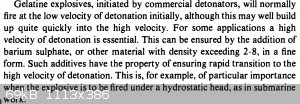
Now, I need to insert high density material in NG gelatine to reach the max VoD , Al has density of 2.7 g/cm³ !
I have MnO2(Density: 5.03 g/cm³) and Fe2O3 (Density: 5.24 g/cm³) but Hennig remarked before that even sand can cause problem so think about metals !
I feel that I am going to increase the sensitivity of NG a lot with this idea !
the book didn't even mention the quantity I need to add !
do any body have any valuable idea ?
[Edited on 27-7-2015 by ecos]
[Edited on 27-7-2015 by ecos]
|
|
|
kecskesajt
Hazard to Others
  
Posts: 299
Registered: 7-12-2014
Location: Hungary
Member Is Offline
Mood: No Mood
|
|
Maybe other exlplosive powders like PETN or HMX or even TNT.What about diatomaceus earth?That way used in the first dynamites.Or wood dust.
Al makes ETN much more sensitive.
[Edited on 27-7-2015 by kecskesajt]
|
|
|
Tabun
Harmless

Posts: 38
Registered: 17-4-2015
Member Is Offline
Mood: No Mood
|
|
Quote: Originally posted by ecos  |
the initiator in patent above depend on PETN and special casing design of the detonator !
[Edited on 27-7-2015 by ecos] |
The only special thing I have seen in that patent is the thickness of the blasting cap's bottom.And it doesn't only mention PETN.If PETN would
work,why wouldn't ETN?
Does anybody have any experience with Nitroglycide and gelatine made with this?
|
|
|
Bert
Super Administrator
        
Posts: 2821
Registered: 12-3-2004
Member Is Offline
Mood: " I think we are all going to die. I think that love is an illusion. We are flawed, my darling".
|
|
Or you could just use a thin gelatin (ca 2-3% NC) and make a 60% NG ammonium nitrate/wood flour based gelignite. THAT will not likely fire at the low
velocity quoted.
I long ago fired a small sample of 2% NC jelly soaked 200 mesh granular magnalium, ratio about 40% jelly to 60% 50:50 Mg/Al powder. Bled jelly if
allowed to sit, had to pack in plastic film. It worked very well in a .75" Dia. charge, producing a flat, high pitched CRACK! similar in tone to a
heavy PETN det cord- but I did not bother to determine the velocity. Flash of light it gave was AMAZING.
[Edited on 28-7-2015 by Bert]
Rapopart’s Rules for critical commentary:
1. Attempt to re-express your target’s position so clearly, vividly and fairly that your target says: “Thanks, I wish I’d thought of putting it
that way.”
2. List any points of agreement (especially if they are not matters of general or widespread agreement).
3. Mention anything you have learned from your target.
4. Only then are you permitted to say so much as a word of rebuttal or criticism.
Anatol Rapoport was a Russian-born American mathematical psychologist (1911-2007).
|
|
|
ecos
Hazard to Others
  
Posts: 464
Registered: 6-3-2014
Member Is Offline
Mood: Learning !
|
|
@kecskesajt , all what you stated has low density and the concept is not to add absorbent like diatomaceus earth
adding PETN , TNT ,... would be a very expensive solution ! adding Metal to increase the density would be a better solution.
I am not sure if adding metal powder (Fe2O3 or MnO3) would add a lot of hazard to the NG gelatine or not ! I am not expert with NG mixtures.
@Tabun, he mentioned to press it well to reach a high density initiator, I think ETN will work but I didnt like the patent concept !
@Bert, here is what i found for AN mixtures with NG :
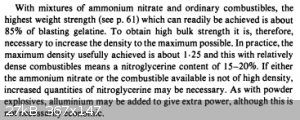
The maximum power would reach 85% of blasting gelatine , this means lower VoD and it might not work for shaped charges !
I found some mixtures stated in US4764229
I made hard search for compositions and I found this mixture from the patent above:
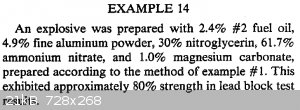
It is also noted the power has 80% strength even after adding Al powder  !
unfortunately, The author didn't provide any info about VoD and I am stuck to calculate it myself. !
unfortunately, The author didn't provide any info about VoD and I am stuck to calculate it myself.
[Edited on 28-7-2015 by ecos]
[Edited on 28-7-2015 by ecos]
|
|
|
PHILOU Zrealone
International Hazard
    
Posts: 2893
Registered: 20-5-2002
Location: Brussel
Member Is Offline
Mood: Bis-diazo-dinitro-hydroquinonic
|
|
The sensitivity of NG when frozen comes also from tiny bubbles entrapped into the matrix, generating hot spots when shocked by a compression wave.
Tawing usually generate a risk of local overheating and hence deflagration and detonation.
Same effect is seen with microballoons and low density NH4NO3 for sensitivity increase.
[Edited on 28-7-2015 by PHILOU Zrealone]
PH Z (PHILOU Zrealone)
"Physic is all what never works; Chemistry is all what stinks and explodes!"-"Life that deadly disease, sexually transmitted."(W.Allen)
|
|
|
ecos
Hazard to Others
  
Posts: 464
Registered: 6-3-2014
Member Is Offline
Mood: Learning !
|
|
Quote: Originally posted by Bert  | Or you could just use a thin gelatin (ca 2-3% NC) and make a 60% NG ammonium nitrate/wood flour based gelignite. THAT will not likely fire at the low
velocity quoted.
|
I made some searches in Naoum book and found that any mixture has NG as ingredient will suffer the same problem of low VoD :
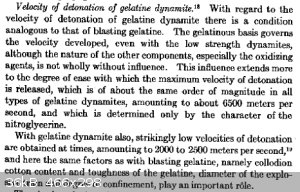
and
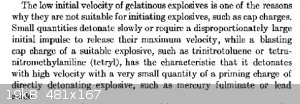
even storage will affect the sensitivity and very strong cap would be needed to get the max VoD. (cap8)
it seems detonation of NG is not an easy thing :
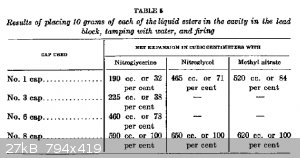
[Edited on 3-8-2015 by ecos]
|
|
|
ecos
Hazard to Others
  
Posts: 464
Registered: 6-3-2014
Member Is Offline
Mood: Learning !
|
|
Regeneration of sulfuric acid nitrating mixtures (after synthesis nitroglycerin)
Very interesting video about Regeneration of sulfuric acid nitrating mixtures (after synthesis nitroglycerin)
https://www.youtube.com/watch?v=DASQdQMwaB4
|
|
|
| Pages:
1
..
23
24
25
26
27 |